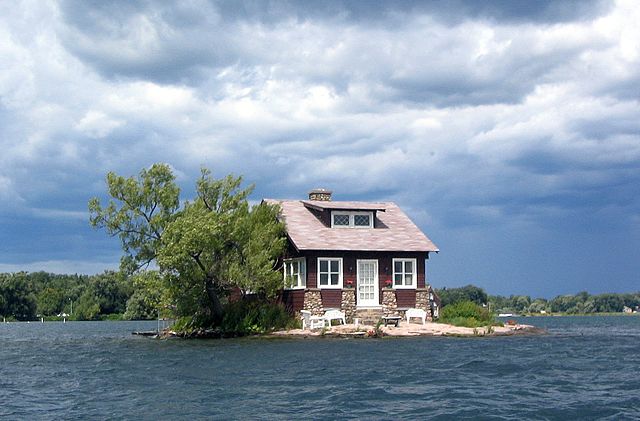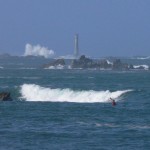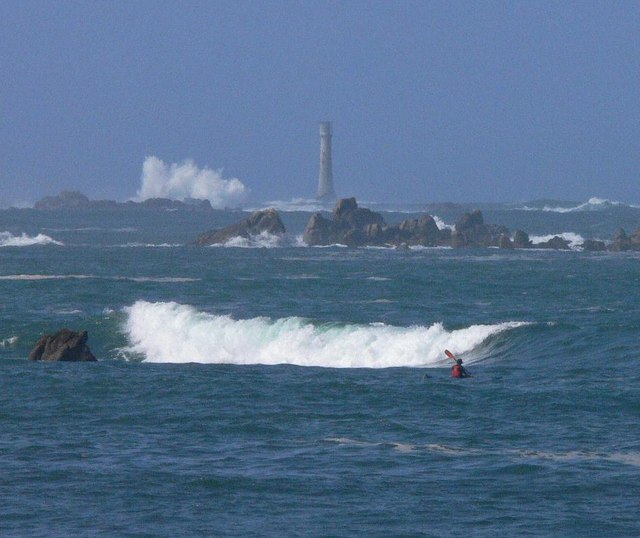Bishop Rock, also known as “Men an Eskob” in Cornish, is a rock emerging from the sea about 3 kilometers west of the Scilly Isles, off the western tip of Cornwall. The only building on this rock is the eponymous lighthouse, the third built from 1858 to warn sailing ship about ht Western Rocks, that are a group of scattered rocks and uninhabited islands which caused many shipwrecks over the centuries .
Island or rock?
![© Copyright Peter Jordan [CC-BY-SA-2.0] Bishop_Rock_Lighthouse_SV8006](https://www.laputa.it/wp-content/uploads/2013/03/Bishop_Rock_Lighthouse_SV8006-225x300.jpg)
Bishop Rock (Men an Eskob) with the lighthouse: the biulding is 49 metres high. © P. Jordan, 1996 (CC-BY-SA-2.0, Geograph)
A story that is still very popular, often reported in the media and copy-pasted from one blog to another[1] claims that the famous book Guinnes World Records would have identified Bishop Rock as the smallest island in the world. This record would be based on an ancient British law of 1861 which would establish, for census purpouses, two minimum requirements to be called “island”: namely that was inhabitated, otherways which had enough room to ensure the «summer pasturage of at least one sheep». This latter condition would be met, according to the bureaucrats, by having an area of at least two acres.
The area
Although the idea of assigning the title of “island” to such a small rock may be fascinating, it soon proves to be implausible, especially to a surveyor’s eyes. Bishop Rock is not permanently inhabited, so the first option is out. Let’s go for the second. For starters, on Bishop Rock there is no grass, so a possible sheep would have very little to graze. Aside from this, an acre is easily found to be 4 840 square yards, and one yard is 0,9144 metres, thus 1 yd² ≈ 0,84 m². So, two acres are equivalent to:
2 ac = 2 x 4840 yd² = 2 x 4840 x (0,9144 m x 0,9144 m) = 8093,72 m²
Therefore, it is not necessary to be a seasoned surveyor to look at the images and, using the height of the lighthouse (49 meters[2]) as a reference, deduce that an area of two acres is completely implausible. Sailing to the rock and measure it would prove an impratical difficult task, but we can get to know its size through a different approach: according with Trinity House, that is the general autority for lighthouses of England, Galles and Channel Islands, the islet is «46m long by 16m wide»,[2] so nevertheless no larger than 736 m². But, as long as a rock usually isn’t rectangle-shaped, it should be a bit more realistic to consider, with broad approximation, an ellipse whose axes correspond to the “width” and “length” provided by the authority:
π x 16/2 m x 46/2 m = 578,05 m²
that is only 0,14 acres. This measure appears far more plausible of the two acres required by the alleged Victorian rule. It is also true that at that age time the value of Acre could change locally,[3] but in 1861 the different units of measure in the United Kingdom had already been merged by force of the “Weights and Measures Act ” issued in 1824: the supposed rule would therefore have had to refer to acre as defined by British Imperial System.
The “primacy”
The Guinnes World Records could not run into such a gross mistake: in fact it would be enough to give it a look to find out that the famous book there is no cluw of this supposed primacy. To take away all doubt we checked almost all the Italian editions from 1968 until today:[4] in none of them does Bishop Rock appear and, being “world” records, the English editions should not be no means different. Moreover, Bishop Rock does not even appear in the online edition of the book.
The rule
After verifying that the GWR does not confirm this statement, let’s go for checking the existence of a british standard according to wich a island must have enough room to ensure the summer grazing of a sheep. It is not necessary to go over all the archives of the United Kingdom with a fine tooth comb: the British government has indeed put online the majority of the legislative corpus produced since 1271 (including local regulations) on the site legislation.gov.uk. Well, even expanding your search to the nineteenth century and to the documents in the Welsh language, it seems to be no law, ordinance, regulation fixing the minimum size of an island in two acres. In itself this is not enough to state that it never existed (moreover, even the “Weight and Measures Acts” are listed on the site), but definitely does not confirm anything. It is also symptomatic that Trinity House, in the page dedicated to the history of the lighthouse in its official website, does not even mention the alleged primacy. Finally J. Calder, author of the website World Island Information entirely dedicated to the geography of the islands, get rid of this businnes reporting it as an «unwarranted claim».[5]
Conclusion
Finally, we can find three precondition on which rests the story of the alleged “smallest island in the world”:
- «an old bureaucratic regulation fixed in two acres the minimum area of an island».
Uncertain, we haven’t found any trace of such rule (though certainly bizarre regulations aren’t rarity); - «Bishop Rock has an area of two acres».
False, as we have above seen it’s about fourteen times smaller – or even less; - «consequently , the Guinness World Records locates in Bishop Rock the smallest island in the world»
False, we can say with reasonable certainty that the GWR never referred to Bishop Rock.
Two false postulates and an uncertain (but most probably groundless) one are enough evidence to believe that this is either an hoax or a legend; perhaps made more credible by a date (1861) and an authoritative source such as the Guinnes World Records, so much so that no one will care to check.
What then is the smallest island in the world?
It is impossible to determine an actual “world’s smallest island”, as there is not an unambiguous definition of “minimal island”, below which we would call it a rock. In addition, there may be hundreds or thousands of islets of similar characteristics, without counting the difficulty of precisely defining the area of a small, uneven surface often subject to tides. What is certain is that there are definitely inhabited islands much smaller than the Bishop Rock (which is also uninhabited) For example, near Noank (Connecticut) there is an island called “Mouse Island” (or “Muse Island”) that is of 1,5 acres on wich there are three residential houses; not far away, at the mouth of the river Thames (the american one) there is another one known Hobs Island, sized just half an acre, whit a single house.[6] An islet meaningfully called Just Room Enough, in the Thousand Islands archipelago along the Lawrence River (on the border between Canada and the US) has an area of just over 500 m² and above it there is a small house.[7]

The islet called “Just Enough Room”, on the Lawrence River between Stati Uniti and Canada.
Omegatron/Commons 2006 (CC-BY-SA 3.0)
Note

- [1]Let try to do a search on the internet with the keywords “bishop + rock + guinness + record” or “bishop + rock + smallest + island” to see how this legend is widespread.↩
- [2]“Bishop Rock Lighthouse.” Trinity House. Web. 6-3-2013.↩
- [3]“acre (unit of measurement).” Britannica Online Encyclopedia. ©2013 Encyclopædia Britannica, Inc. Web. 5-3-2013.↩
- [4]Checked editions (with specification of the pages the pages which refer to the islands): Guinness dei primati (the Italian edition of Guinnes World Records) 1968, 1971 (pp.98-99), 1981 (pp.69-70), 1982 (pp.69-70), 1983 (pp.68-69):, 1984 (pp.68-69), 1985, 1986, 1989 (pp.69-70), 1990 (pp.69-70), 1991 (pp.69-70), 1992 (pp.81-82), 1994 (pp.79-80), 1996 (pp.20, 22), 1997 (pp.21-22), 1998 (pp.19-20). Since 1999 the name changes to Guinnes World Records
: checked editions 1999 (pp.27,167,254), 2000 (p.68), 2001 (157,254), 2003 (pp.77, 94, 132, 135), 2004 (pp. 43, 79), 2005 (56-57), 2006 (nessuna isola), 2007 (p.25), 2008 (pp 26, 27-28), 2009 (p. 272), 2010 (pp. 33-34, 36, 149), 2011 (40-41), 2012 (pp. 36, 42, 72, 263), 2013. No trace of Bishop Rock. Since the publication began in 1955 and translated into Italian in 1967, we can state 65% that a goos 65% of the Italian editions have been checked. Many thanks to Giorgio Castiglioni of Bibliotopia (Libraries of Drezzo, Gironico, Moltrasio e Parè), Francesco Bianchi and Gianluca Gattelli for the accurate and extensive search.↩
- [5]Calder, Joshua. “Island Superlatives.” World Island Info – The Geography of the World’s Islands. Web. 17 Mar. 2013.↩
- [6]Streeter, James L. “Noank’s “Muse” Island.” Groton: historical bits and pieces
. New York: iUniverse Inc., 2009. Pag. 217.↩
- [7]Beres, Naomi. “The world’s 10 tiniest houses on tiny islands” Hub Pages. 13 Nov 2014. Web. 26-4-2015.↩
Thanks to Bibliotopia (Libraries of Drezzo, Gironico, Moltrasio and Parè) for the extensive search on the Guinnes World Records.
Originally published in Italian 3th Mar, 2013.




